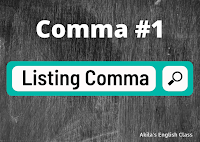Pausing Punctuation mark – Comma
There are three punctuation marks which indicate
pause in English Language. They are called Pausing punctuation marks or Pausing
punctuation points.
There are three terminal punctuation marks – those that are used at the end of a sentence. They are the Full Stop, the Question Mark and the Exclamation Mark.
Pausing Punctuation Marks (used in the middle of sentences)
1. Comma (,)
2. Semicolon (;)
3. Colon (:)
Comma is perhaps one of
the frequently used punctuation marks.
The use of comma may be confusing at times as it is used in many different ways. Comma is used to indicate a pause when the text is spoken aloud. (This use of comma is misleading as spoken and written language use pauses differently). Comma is also used to separate grammatical components of a sentence.
While the use of comma may be confusing, it is strongly advised to avoid Comma Splice. When a comma is used incorrectly Comma Splice happens.
The Comma by its presence or absence may alter the meaning of a sentence. The above two popular examples highlight how the use of comma changes the meaning dramatically.
The 4 Main uses of Comma
1. Listing Comma
2. Joining Comma
3.
Gapping Comma
4.
Bracketing Comma
While each of the above has different rules, note that a comma is never preceded by a white space and always followed by a white space.
1. Listing comma
Listing Comma is used
in a list when three or more words, phrases or even complete sentences are
joined by the word and or or.
a. three or more items
in a series.
Example:
I like apples, bananas and grapes.
Vijay has visited Paris, London
and New York.
Raju likes to read horror
books, Reena likes to read self-help books and I like to read both.
Note:
In the above two sentences the commas could be replaced by the word and or or.
I like apples and bananas and
grapes.
Vijay has visited Paris and
London and New York.
Raju likes to read horror
books and Reena likes to read self-help books and I like to read both.
Note:
Even though the above sentences are grammatically correct, they are awkward to
read.
b. a series of three or more independent clauses / sentences.
Example: Vijay is from Punjab, Swami is from
Tamilnadu and Kartik is from Delhi.
Note: A comma is never used to separate two independent clauses / sentences but three or more independent clauses / sentences and the word ‘and’ or ‘or’.
Example: Vijay is from Punjab, Swami is from Tamilnadu is incorrect.
The serial comma also known as the ‘Oxford comma’ in the UK is a comma placed before the last item in a list of three or more things. Break normal convention with Oxford comma if it makes the text less ambiguous.
2.
Joining comma - to join two complete sentences into one.
 |
Note: Connect two complete
sentences with a comma only if there is coordinating conjunction (For, And,
Nor, But, Or, Yet, So or FANBOYS), between them. Do not use
joining comma in any other condition.
The connecting words however,
therefore, hence, consequently, nevertheless, and thus cannot be used
after a joining comma.
Example:
Correct - I like reading, and I
like singing.
Wrong – I like reading and I like singing.
3. Gapping comma - in place of words to avoid repetition.
Gapping comma is used to replaces
certain words which are repeated. These repeated words can be dropped and a
gapping comma used instead.
Example:
I like to read motivational and
self-help books; my sister likes to read crime and humour.
I like to read motivational and
self-help books; my sister, crime and humour.
Such non-essential information is called a ‘non-restrictive phrase’ or a ‘weak interruption’.
The bracketing commas work like a pair of brackets.
Check the use of Bracketing Commas: If the sentence makes complete sense without the
portion of sentence between the commas, it may be said that the use of commas
is right.
The portion of
the sentence which is the ‘non-essential information’ can be a clause, phrase
or a word.
Examples:
Clause as non-essential information
This Friday, which happens to be my birthday,
is the only day when I can be with my family.
Phrase
as non-essential information
The restaurant
has an excellent ambience. The menu, on
the other hand, is not exciting.
Word as
non-essential information
Your sincerity was
never doubted. In this project, however,
you have exceeded expectations.
Note: Bracketing commas are usually used in pairs.
Learn to use this squiggle wisely and correctly!!!











0 Comments